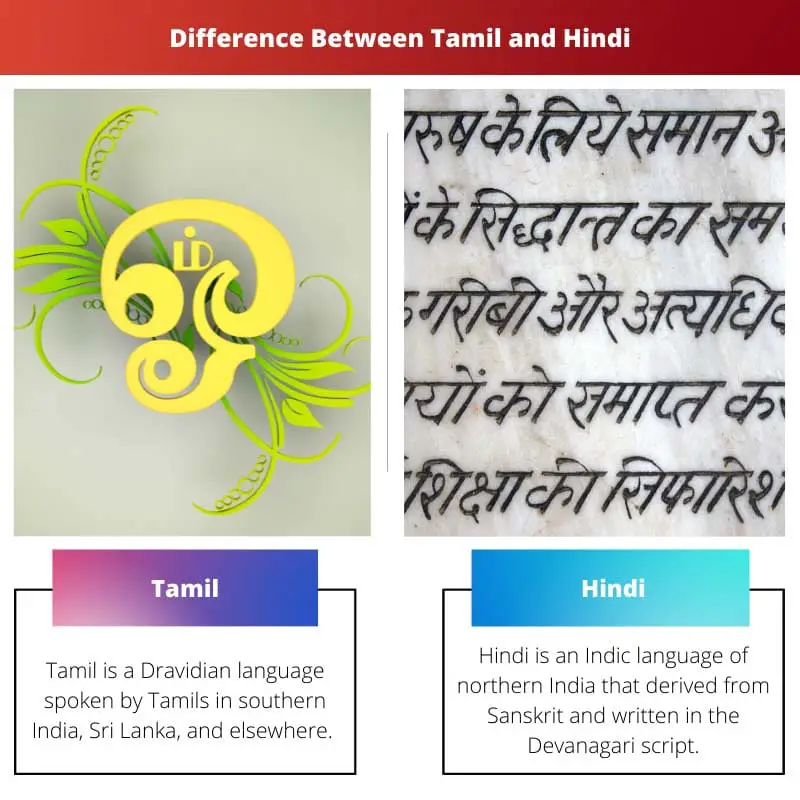Tamil and Hindi are both prominent languages in India, but they stem from different language families, with Tamil belonging to the Dravidian family and Hindi to the Indo-Aryan family. While Tamil is primarily spoken in the southern state of Tamil Nadu and parts of Sri Lanka, Hindi serves as the official language of the Indian government and is widely spoken in the northern and central regions of India.
Key Takeaways
- Tamil is spoken predominantly in the southern Indian state of Tamil Nadu, while Hindi is the primary language of the northern Indian states.
- Tamil is a Dravidian language, while Hindi is an Indo-Aryan language.
- Hindi uses the Devanagari script for writing, while Tamil uses a Tamil script.
Tamil vs Hindi
Tamil is a Dravidian language with a rich literary tradition and a unique script. Hindi is an Indo-Aryan language spoken in northern and central India and is the official language of India. It is written in the Devanagari script and is known for its simple grammar and phonetics.

Tamil is derived from the Dravidian language family written in Tamil scripts. It is one of the four Dravidian languages, along with Telegu, Malayalam, and Kannada.
It is the oldest of all Dravidian languages. This language has existed for more than 2000 years, making it the world’s oldest and longest-surviving classical language.
Hindi is considered one of the official languages of India and is taught in many areas of the country. Generally, Hindi spoke by the people of the central and northern regions of the country as the first language.
It is allocated under the Indo-European linguistic family and further classified into the central family, shambolic, and Indo-Aryans.
Comparison Table
| Feature | Tamil | Hindi |
|---|---|---|
| Language Family | Dravidian | Indo-European (Indo-Iranian branch) |
| Geographic Origin | Southern India, Sri Lanka, parts of Southeast Asia | Northern India, Pakistan, Nepal, parts of the Middle East and Africa |
| Number of Speakers | ~80 million (native speakers) | ~615 million (native speakers) |
| Official Language | India (at the national level and in several states), Sri Lanka, Singapore | India (at the national level and in several states) |
| Writing System | Tamil script | Devanagari script (derived from Brahmi script) |
| Sound System | Consonantal system with retroflex consonants, vowel harmony | Consonantal system with aspirated consonants, no vowel harmony |
| Grammar | Agglutinative language with suffixes added to root words | Inflected language with prefixes, suffixes, and internal modifications to words |
| Vocabulary | Limited Sanskrit influence, large number of unique words | Heavily influenced by Sanskrit, Arabic, Persian, and Turkic languages |
| Literary Tradition | Extensive literary tradition dating back over 2,000 years | Rich literary tradition dating back over 1,000 years |
| Cultural Significance | Deeply connected to Tamil culture, identity, and history | Plays a central role in Indian culture and national identity |
What is Tamil?
Tamil is a classical language primarily spoken in the southern Indian state of Tamil Nadu and in parts of Sri Lanka, Singapore, Malaysia, and other diaspora communities around the world. It is one of the oldest living languages with a rich literary tradition spanning over two millennia.
Linguistic and Historical Significance
- Dravidian Language: Tamil belongs to the Dravidian language family, distinct from the Indo-European languages like Hindi, Bengali, and Gujarati spoken in other parts of India.
- Ancient Origins: The history of Tamil dates back to at least 500 BCE, evidenced by inscriptions and literary works from that era. It is one of the classical languages of India, alongside Sanskrit, and has a vast body of literature, including Sangam literature, which dates back to the 3rd century BCE to the 4th century CE.
Cultural Importance
- Literature and Poetry: Tamil literature is renowned for its richness and diversity, encompassing various genres such as poetry, prose, drama, and epics. Works like the “Tirukkural” and the “Silappatikaram” are celebrated as masterpieces of Tamil literature.
- Religious Texts: Tamil has been the language of many ancient religious texts, including the Tirukkural, revered by both Hindus and non-Hindus for its moral teachings, and the Tamil Sangam literature, which includes devotional poetry dedicated to various deities.
Modern Context
- Contemporary Usage: Tamil continues to thrive as a spoken and written language, not only in its traditional homeland but also among Tamil diaspora communities worldwide. It has a vibrant media presence, with newspapers, magazines, television channels, and movies produced in Tamil.
- Political and Social Identity: Tamil language and culture have played a significant role in shaping the identity and politics of the Tamil-speaking people, both in India and Sri Lanka. The language has been a focal point in discussions surrounding regional autonomy and cultural preservation.

What is Hindi?
Hindi is an Indo-Aryan language spoken primarily in northern and central India. It serves as the official language of the Indian government and is one of the most widely spoken languages in the world.
Linguistic and Historical Background
- Indo-Aryan Language: Hindi belongs to the Indo-Aryan branch of the Indo-European language family, which also includes languages like Bengali, Punjabi, and Gujarati.
- Sanskrit Influence: Like other Indo-Aryan languages, Hindi has significant lexical and structural influence from Sanskrit, an ancient Indic language. This influence is particularly evident in Hindi’s vocabulary and literary traditions.
Cultural and Literary Importance
- Hindi Literature: Hindi boasts a rich literary tradition that spans centuries, with notable works ranging from medieval poetry and epics to modern novels and essays. Renowned poets like Kabir, Tulsidas, and Mirabai have contributed significantly to Hindi literature.
- National Language: Hindi holds a special status as the official language of the Indian government, alongside English. It is used for communication at the central government level and is one of the 22 scheduled languages of India.
Modern Context
- Media and Entertainment: Hindi serves as the lingua franca of India’s vibrant film industry, Bollywood, which produces a vast number of movies annually, not only for domestic audiences but also for audiences worldwide.
- Educational and Administrative Use: Hindi is widely used in education, administration, and media across India. Many schools and universities offer Hindi as a subject, and proficiency in Hindi is a requirement for government jobs.
Sociopolitical Significance
- Language Politics: Hindi has been a subject of linguistic and political debate in India, especially in regions where it is not the native language. Language movements advocating for linguistic rights and preservation of regional languages have occurred in states where Hindi is not widely spoken.
- Unity in Diversity: Hindi, while being a unifying force in many contexts, also reflects India’s linguistic diversity. It coexists with numerous other languages and dialects spoken throughout the country, contributing to India’s multicultural fabric.

Main Differences Between Tamil and Hindi
- Language Family:
- Tamil belongs to the Dravidian language family.
- Hindi is an Indo-Aryan language.
- Geographical Distribution:
- Tamil is primarily spoken in the southern Indian state of Tamil Nadu, as well as in parts of Sri Lanka, Singapore, Malaysia, and among diaspora communities.
- Hindi is predominantly spoken in northern and central India and serves as the official language of the Indian government.
- Script and Alphabet:
- Tamil uses its own unique script known as the Tamil script.
- Hindi is written in the Devanagari script, which is also used for several other Indian languages.
- Cultural and Literary Heritage:
- Tamil has a rich literary tradition dating back over two millennia, including the Sangam literature and classical poetry.
- Hindi also boasts a diverse literary heritage, with renowned works from medieval poetry to modern literature, including contributions from poets like Kabir and Tulsidas.
- Official Status and Political Significance:
- Tamil holds official status in the state of Tamil Nadu and has historical significance in the politics of Tamil identity, particularly in discussions surrounding regional autonomy.
- Hindi serves as the official language of the Indian government and is used extensively in administration, education, and media, though it has faced opposition in regions where it is not the native language.
- Cultural Influence and Media Presence:
- Tamil culture has a significant impact on art, music, and cinema, with the Tamil film industry, known as Kollywood, being one of the largest in India.
- Hindi, particularly through Bollywood, dominates the Indian film industry and has a global audience, contributing to its widespread recognition and influence.






